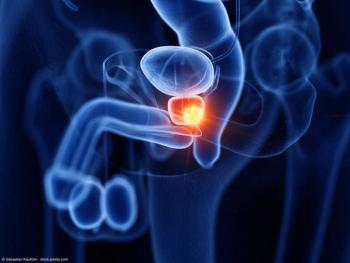
Potential biomarkers emerge for 177Lu-PSMA-617 in metastatic prostate cancer
177Lu-PSMA-617 is approved by the FDA for the treatment of patients with PSMA-positive metastatic castration-resistant prostate cancer in the post androgen receptor pathway inhibition, post taxane-based chemotherapy setting.
Findings from the phase 2 TheraP trial published in the Lancet Oncology identified potential predictors of response to 177Lu-PSMA-617 (lutetium Lu-177 vipivotide tetraxetan; Pluvicto) in patients with metastatic castration-resistant prostate cancer (mCRPC).1
Specifically, mean standardized uptake value (SUVmean) of PSMA appeared to be a predictive biomarker for response to 177Lu-PSMA-617 vs cabazitaxel (Jevtana), while high FDG-PET metabolic tumor volume (MTV) was linked to worse responses in both arms.
With a median follow-up of 18.4 months, 35% (n = 35/99) of patients who received 177Lu-PSMA-617 and 30% (n = 30/101) of those who received cabazitaxel had high PSMA-PET uptake, defined as a SUVmean of 10 or more. The PSA response rate for patients with a SUVmean of 10 or more receiving 177Lu-PSMA-617 and cabazitaxel, respectively, was 91% (95% CI, 76%-98%) vs 47% (95% CI, 29%-65%). For patients with a SUVmean of less than 10, the PSA response rates were 52% (95% CI, 39%-64%) vs 32% (95% CI, 22%-45%), respectively.
The multicenter, open-label, randomized phase 2 TheraP trial (NCT03392428) was conducted across 11 hospitals in Australia and enrolled a total of 200 patients with mCRPC following treatment with docetaxel (Taxotere) who were suitable to receive cabazitaxel. A total of 101 patients received a 20 mg/m2 dose of cabazitaxel intravenously every 3 weeks for up to 10 treatment cycles, and 99 patients were assigned to receive a starting dose of intravenous 177Lu-PSMA-617 at 8.5 GBq every 6 weeks for up to 6 cycles. The dose was then decreased by 0.5 GBq every cycle down to a minimum of 6.0 GBq.
Patients 18 years and older were eligible to enroll on the trial if they had adequate hematological, renal, and liver function, as well as an ECOG performance status of 0 to 2. The primary end point was PSA response rate, which was defined as the proportion of patients with a PSA reduction of at least 50% from baseline. Secondary end points included radiographic progression-free survival (rPFS) and PSA PFS.
At baseline, the mean PSMA-PET MTV for patients in the cabazitaxel and 177Lu-PSMA-617 cohorts, respectively, was 949 mL and 1082 mL. The mean PSMA-PET SUVmax was 57 and 66, and the PSMA-PET SUVmean was 9.3 and 9.7 across each respective cohort. Moreover, the mean FDG-PET MTV was 219 mL and 187 mL, the mean FDG-PET SUVmax was 11 in both respective arms. The FDG-PET SUVmean was 4.36 and 4.42 across each respective cohort. The percentage of patients who had a FDG MTV of 200 mL or more was 30% in the cabazitaxel arm and 30% in the 177Lu-PSMA-617 arm.
The PSA response rate across both treatment cohorts was 38% (95% CI, 26%-52%) for patients with an FDG-PET MTV of 200 mL or more and 56% (95% CI, 48%-65%) for patients with an FDG-PET MTV of less than 200 mL (odds ratio, 0.44; 95% CI, 0.23-0.84; P = .035).
In terms of rPFS rates in patients treated with 177Lu-PSMA-617 vs cabazitaxel, the HR was 0.46 (95% CI, 0.25-0.84) for those with a PSMA-PET SUVmean of at least 10 and 0.85 for those with a PSMA-PET SUVmean of less than 10 (95% CI, 0.59-1.24). Results were comparable in the PSA PFS analysis in patients with a PSMA-PET SUVmean of at least 10 (HR, 0.45; 95% CI, 0.25-0.80) and those with a PSMA-PET SUVmean of less than 10 (HR, 0.77; 95% CI, 0.53-1.12). Notably, patients who had a FDG-PET MTV 200 mL or greater also tended to have a worse rPFS (HR, 1.79; 95% CI, 1.28-2.52; P = .0008) and PSA PFS outcome (HR, 1.44; 95% CI, 1.03-2.02; P = 0.031).
Reference
1. Buteau JP, Martin AJ, Emmett L, et al. PSMA and FDG-PET as predictive and prognostic biomarkers in patients given [177Lu]Lu-PSMA-617 versus cabazitaxel for metastatic castration-resistant prostate cancer (TheraP): a biomarker analysis from a randomised, open-label, phase 2 trial. Lancet Oncol. 2022;23:1389-1397. doi:10.1016/S1470-2045(22)00605-2
Newsletter
Stay current with the latest urology news and practice-changing insights — sign up now for the essential updates every urologist needs.


















